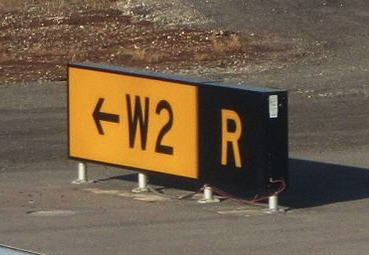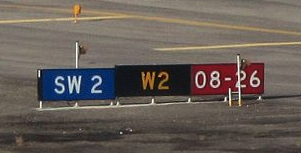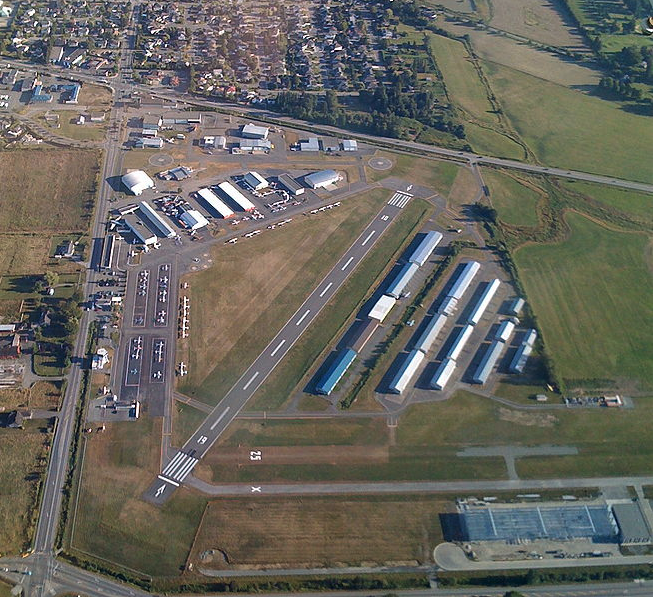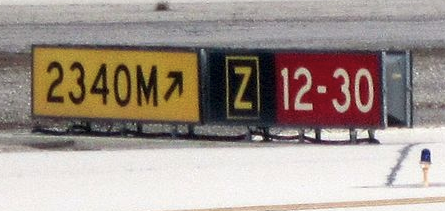You’re on your plane, flying to wherever. You’ve snagged a window seat and the flight attendant hasn’t said to keep your window shade down (sometimes they do; here’s why.). So you’re looking out the window as you’re taxiing.
You notice different signs, sometimes with letters, sometimes with numbers, sometimes both. Sometimes they’re yellow on black. Sometimes they’re black on yellow. And other times they’re totally different colors, like white on red or blue. Like these:


(PC: public domain)
Ever wonder what all those signs mean? What if I told you that if you knew what they meant, you’d know where on the tarmac you were and possibly where on it you’d be heading next? But before you learn the secret code, let’s get down to basics.
There are 2 different types of “roads,” if you will, that planes follow on tarmacs before they take off:
- Runways – According to the International Civil Aviation Organization, a runway is a “defined rectangular area on a land aerodrome prepared for the landing and takeoff of aircraft”. Runways may be a man-made surface or a natural surface.
- Taxiways – a path for aircraft at an airport connecting runways with aprons, hangars, terminals and other facilities. They mostly have a hard surface such as asphalt or concrete, although smaller general aviation airports sometimes use gravel or grass. Most airports do not have a specific speed limit for taxiing.
Thanks, Wikipedia!
So runways are the long roads where you either start acceleration so your plane can take off, or what you initially touch down upon when you land. Taxiways are the roads that get your plane to/from the runway.

Diagonal road: Runway. Feeder roads: Taxiways
PC: Ludraman / Creative Commons License
The signs along taxiways and runways
As you go past all these signs, you’ll notice there are more black and yellow signs than red or blue ones. The ones with letters represent a taxiway. The signs with numbers are representative of runways.
So if you see a black sign with yellow letters, that indicates you’re on the taxiway it identifies. So this picture was taken when the person was on taxiway Z:

Using the same photo above, a yellow sign with black lettering and a black arrow is a directional sign. It identifies the intersecting taxiways the aircraft is approaching, with an arrow indicating the direction to turn (Fun fact! Directional signs will always be on the left side of the taxiway before the intersection. FAA rule).
So going back to the photo above, we know this person was on runway Z, but we also know they were approaching runway 2340, which would be towards the right.
The meaning of a red sign for pilots is the same as it is for anyone else – CAUTION! STOP! They show entrances to runways or critical areas. Both aircraft and vehicles are required to stop at these signs until the control tower gives them clearance to proceed.
Once again going to the photo above, since we know that signs with numbers mean a runway, and the 12-30 is red, it means the pilot has to stop there because they’re about to cross runway 12-30. Once ATC gives them the OK, they can continue on their intended path.
Other signs you may see:

Stop Bar signs – white on blue background. The designation consists of the letter S followed by designation of the taxiway on which the Stop Bar is positioned. This sign is not standard (some airports use lights instead).
Frequency change signs – Usually a stop sign and an instruction for those in the cockpit to change to another radio frequency. These signs are used at airports with different areas of ground control.
FBO sign – A yellow airport sign that says “FBO” in black lettering, with an arrow on it. This directs the pilot to the destination for arriving aircraft (another FAA rule). “FBO” stands for “Fixed-Base Operators,” which are the companies at the airports that take care of fueling up the planes, tying them down, removing the baggage from the cargo area, etc. This is also a directional sign to where passengers will be able to disembark and enter the terminal.
Want to comment on this post? Great! Read this first to help ensure it gets approved.
Want to sponsor a post, write something for Your Mileage May Vary or put ads on our site? Click here for more info.
Like this post? Please share it! We have plenty more just like it and would love it if you decided to hang around and sign up to get emailed notifications of when we post.
Whether you’ve read our articles before or this is the first time you’re stopping by, we’re really glad you’re here and hope you come back to visit again!
This post first appeared on Your Mileage May Vary

4 comments
Sorry, nice try but not even close to correct. I appreciate the idea of educating passengers about the meaning of signs on the airfield but “they were approaching runway 2340”? No. Confusing and wrong.
I was writing it as someone who is not an aviation geek, but looked at several websites – also not for aviation geeks or pilots – with the intention of explaining it to, well, people like me. Read: folks who don’t know or care about the minutia of aviation but maybe want to learn a little more about what they’re seeing when they look out the window of a plane. 😉 If what I wrote was “confusing and wrong,” could you reply and explain it in layman’s terms? Thanks!
Actually 2340M means that at this intersection, you are 2340 meters from the take off run of the runway, which is the total distance that you are safe to take off on the runway. And that runway is identified as 12-30. Which means the runway is on the axis of 120 deg on the compass, or 300 deg if you land or take off on the opposite direction.
Runway Z😂. Taxiways and taxilanes have alphabetical or alpha-numerical names (EX: T, T8). Taxiway/taxilane names are pronounced based off the phonetic alphabet (alpha, Bravo, Charlie, ext.). runways are numerical based off the 360 degree compass heading, rounded to the nearest 10 degrees. Ex: facing 360 (directly north), the runway will be 36, which makes the opposite end 18, because 180 is the opposite end of 360 degrees. In layman’s terms, we don’t care about the “0”, so we remove it from the name. Runways can run parallel to each other, so in that case, we name them the compass direction plus an L, C, or R (literally left, center, right). Signs when approaching a runway are red, like a stop sign, and with the same intended purpose. Yellow signs with black lettering and an arrow are directional signs. if there’s no arrow, it’s just informational. Black background yellow letter is a location (specifically for the taxiway/taxilane, these are not on runways). Some runways have black background white numbers counting down as you move down the runway. Those signs measure the distance remaining in 1000’s of feet.